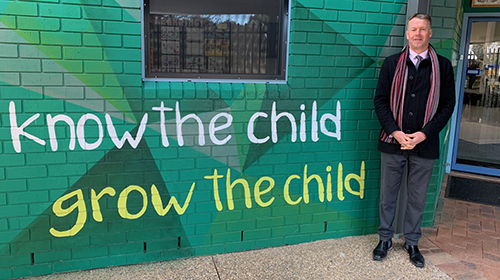
Welcome to Charles Conder Primary School.
Our Vision
This school’s vision enables our community to work towards common goals ensuring children are our focus. The manifesto is embodied by ‘Know the Child – Grow the Child’. Charles Conder Primary School has a strong commitment to providing a safe and harmonious school environment where successful relationships thrive. The strength lies in the close partnership between students, staff, parents and the wider community which is highly valued to us all. We promote and develop positive and respectful relationships. The school motto is: Commitment to Excellence – in a caring, cooperative, purposeful and success-oriented environment.
Our Values and Beliefs
At Charles Conder Primary School our community believes in the manifesto of ‘Know the child, Grow the child’. We incorporate a holistic and collaborative approach to teaching and learning where students belong, feel safe and supported and have high expectations for success.
Learning is student centred, differentiated, authentic and inquiry driven. Teachers analyse data to identify purposeful, personal learning goals allowing for targeted teaching and learning. Feedback and reflection facilitates ongoing learning, ensuring students feel empowered to take risks, extend their thinking and develop a growth mindset.
At Charles Conder Primary school every student is learning and achieving as part of a shared partnership between school and home. As a community we build healthy relationships through trust, respect, support and encouragement.
Know the Child, Grow the Child, at Charles Conder Primary School, you will see:
At Charles Conder Primary School, we are trauma informed and trauma sensitive. ‘Trauma sensitive school interventions are based on the goals of supporting the quality and number of safe and secure relationships a child has; teaching the essential skills of social-emotional competence and increasing the opportunities children have to learn. The focus at Charles Conder is to foster and develop relationships between teachers and all students while ‘building children’s social and emotional competence in order to improve academic engagement and success’ (Australian Government Department of Health).
‘In recent decades neuroscience has established that our brains can change over the lifespan, particularly so, before the age of 25. This neural plasticity is shaped by our experiences and our environments, including those provided in schools. Repeated engagement with environments that the best school, classrooms and teachers provide, can change students’ brains- maximising their individual well-being for learning’ (Rossouw, P). We believe in fostering a growth mindset in our students and maximising each and every learning opportunity.
At Charles Conder Primary School we believe… ‘that the effective traits of teachers (as based on work from Sheena Cameron and Louise Dempsey) are to; know your learners, know your subject, create excitement, model, scaffold and guide all students towards independence and provide purposeful and planned feedback Cameron, S. & Dempsey, L. (2013, p.18)
‘Responsive teaching and assessing means we are always teaching for understanding, continuously checking for understanding and adjusting instruction as needed. It’s not enough to know how to do something; we have to know what we are doing and why we are doing it if we are to apply any ‘how to’ in a worthwhile and sustainable way.’ Routman, R. (2014)
At Charles Conder Primary School you will see us:
- Planning with the end in mind and knowing the big ideas
- Embedding the ‘Assets for life’ to ensure meaningful learning
- Using the inquiry model across all key learning areas to systematically delivery the Australian Curriculum
- Balanced literacy sessions daily which incorporate reading, writing, speaking and listening
- Balanced numeracy sessions daily which incorporate problem solving, number and other mathematical strands
- Asking meaningful and thought provoking questions
- Learning intentions and success criteria are clear and student friendly
- Gradual release of responsibility model is used
- Formative assessment is embedded
- Catch and release to check for understanding
- Teaching is intentional and responsive to point of need ‘How do you know what to move on to tomorrow if you haven’t lived and experienced today? (Miller, D.)
- Learning is differentiated through purposeful collection and analysis of data with targeted groupings, individual goal setting and conferencing
- Feedback and reflection that moves the learning forward
- Visible learning that is purposeful and co constructed
There is a clear expectation that these consistent, school wide effective teaching practices will be implemented by all teachers. There will be consistent evidence of the gradual release of responsibility being used in every classroom, visible learning and high expectations of all students.
